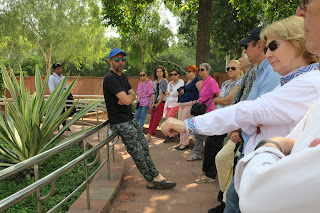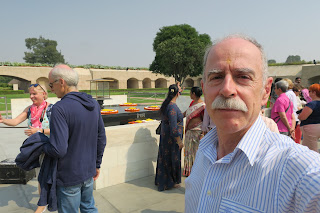Raj Ghat is a memorial dedicated to Mahatma Gandhi in Delhi, India.
Originally it was the name of a historic ghat of Old Delhi (Shahjahanabad).
Close to it, and east of Daryaganj was Raj Ghat Gate of the walled city,
opening at Raj Ghat to the west bank of the Yamuna River. Later the memorial
area was also called Raj ghat.
|
Entering the Raj Ghat.
Located on Delhi's Ring Road, officially known as Mahatma Gandhi Road, a
stone footpath flanked by lawns leads to the walled enclosure that
houses the memorial.
|
|
East entrance.
-
Just south of Raj Ghat is the Gandhi Darshan, a pavilion displaying
photographs showcasing the life of Gandhiji.
-
To the north of Raj Ghat are the memorials for India's first prime
minister, Pandit Jawaharlal Nehru, and two other former prime
ministers of India, Indira Gandhi and Rajiv Gandhi.
|
|
Being lectured on Antyesti.
Being lectured before approaching the spot of Mahatma Gandhi's
cremation, Antyesti (Antim Sanskar).
-
Antyesti literally means "last sacrifice" or "final auspicious
ceremony", and refers to the funeral rites for the dead in Hinduism,
which usually involves cremation of the body.
-
The Antyesti rite of passage is structured around the premise in
ancient literature of Hinduism that the microcosm of all living beings
is a reflection of a macrocosm of the universe.
-
The soul (Atman, Brahman) is the essence and immortal that is released
at the Antyeshti ritual, but both the body and the universe are
vehicles and transitory in various schools of Hinduism.
-
The human body and the universe consist of five elements in Hindu
texts – air, water, fire, earth and space. The last rite of passage
returns the body to the five elements and its origins.
-
See more at
Antyesti - Wikipedia.
|
|
Sunken square courtyard.
Raj Ghat was designed by the America-trained architect Vanu G Bhuta, who
recreated the pattern of the sacred mandala for the memorial.
-
You will note that the memorial (samadhi) is set in the centre of a
sunken square courtyard.
-
It can be approached by four ramps stretching into each cardinal
direction.
-
The whole design is also reminiscent of the ancient architectural
style of India.
|
|
Mahatma Gandhi's Memorial.
It is a black marble platform that marks the spot of Mahatma Gandhi's
cremation, Antyeshti (Antim Sanskar) on 31 January 1948, a day after his
assassination.
-
It is left open to the sky while an eternal flame burns at one end.
-
It is inscribed with the last words of Gandhiji, "Hey Ram", which may
be translated as "O! Lord Ram" or "O! God".
|
|
Mahatma Gandhi statue at Raj Ghat.
Vice-President of India Shri M.Venkaiah Naidu unveiled the 1.80 metre
tall bronze statue of Mahatma Gandhi on the occasion of the 148 Birth
Anniversary of the champion of country’s independence.
-
The statue, sculpted by the renowned Shri Ram Sutar is installed in
the Parking Area of Rajghat Samadhi Complex.
-
It is mounted on a two feet high pedestal clad with granite. The
famous message of Gandhi ji "Be the Change You Wish to See" is
inscribed on the front side of the pedestal.
|
See also
Source
Location









